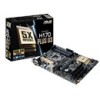Asus H170-PLUS D3 User Guide - Page 76
DB Management, dbx Management
 |
View all Asus H170-PLUS D3 manuals
Add to My Manuals
Save this manual to your list of manuals |
Page 76 highlights
Delete KEK Allows you to delete the KEK from your system. Once the KEK is deleted, the db and the dbx cannot be updated in the operating system. Load Default KEK Select Yes to load the system default KEK or select No to load a downloaded KEK from a USB storage device. Append Default KEK Select Yes to append the system default KEK or select No to append a downloaded additional KEK from a USB storage device for the db and dbx management. The KEK file must be formatted as a UEFI variable structure with time-based authenticated variable. DB Management The db (Authorized Signature database) lists the signers or images of UEFI applications, operating system loaders, and UEFI drivers that you can load on the single computer. Delete the db Allows you to delete the db file from your system. Doing so may cause boot failures. Load Default db Select Yes to load the system default db or select No to load a downloaded db from a USB storage device. Append Default db Select Yes to append the system default db or select No to append a downloaded additional db from a USB storage device to load certain customized UEFI executable files. • The DB file must be formatted as a UEFI variable structure with time-based authenticated variable. • UEFI executable files include UEFI boot devices, drivers and applications dbx Management The dbx (Revoked Signature database) lists the forbidden images of db items that are no longer trusted and cannot be loaded. Delete the dbx Allows you to delete the DBX file from your system. Doing so may expose the system to security threats. Load Default dbx Select Yes to load the system default dbx or select No to load a downloaded dbx from a USB storage device. Append Default dbx Select Yes to append the system default dbx or select No to append a downloaded additional dbx from a USB storage device to forbid certain customized UEFI executable files. The DBX file must be formatted as a UEFI variable structure with time-based authenticated variable. 2-42 Chapter 2: Getting started















